[English] 日本語
 Yorodumi
Yorodumi- PDB-1n8m: Solution structure of Pi4, a four disulfide bridged scorpion toxi... -
+ Open data
Open data
- Basic information
Basic information
| Entry | Database: PDB / ID: 1n8m | ||||||
|---|---|---|---|---|---|---|---|
| Title | Solution structure of Pi4, a four disulfide bridged scorpion toxin active on potassium channels | ||||||
 Components Components | Potassium channel blocking toxin 4 | ||||||
 Keywords Keywords | TOXIN / potassium channel blocker / disulfide bridge stabilized alpha beta motif | ||||||
| Function / homology | Scorpion short toxins signature. / Scorpion short chain toxin, potassium channel inhibitor / Scorpion short toxin, BmKK2 / Knottin, scorpion toxin-like superfamily / ion channel inhibitor activity / potassium channel regulator activity / toxin activity / extracellular region / Potassium channel toxin alpha-KTx 6.4 Function and homology information Function and homology information | ||||||
| Method | SOLUTION NMR / torsion angle dynamics | ||||||
 Authors Authors | Guijarro, J.I. / M'Barek, S. / Olamendi-Portugal, T. / Gomez-Lagunas, F. / Garnier, D. / Rochat, H. / Possani, L.D. / Sabatier, J.M. / Delepierre, M. | ||||||
 Citation Citation |  Journal: Protein Sci. / Year: 2003 Journal: Protein Sci. / Year: 2003Title: Solution structure of Pi4, a short four-disulfide-bridged scorpion toxin specific of potassium channels. Authors: Guijarro, J.I. / M'Barek, S. / Gomez-Lagunas, F. / Garnier, D. / Rochat, H. / Sabatier, J.M. / Possani, L.D. / Delepierre, M. #1:  Journal: Toxicon / Year: 1998 Journal: Toxicon / Year: 1998Title: Two similar peptides from the venom of the scorpion Pandinus imperator, one highly effective blocker and the other inactive on K+ channels Authors: Olamendi-Portugal, T. / Gomez-Lagunas, F. / Gurrola, G.B. / Possani, L.D. | ||||||
| History |
|
- Structure visualization
Structure visualization
| Structure viewer | Molecule:  Molmil Molmil Jmol/JSmol Jmol/JSmol |
|---|
- Downloads & links
Downloads & links
- Download
Download
| PDBx/mmCIF format |  1n8m.cif.gz 1n8m.cif.gz | 115.9 KB | Display |  PDBx/mmCIF format PDBx/mmCIF format |
|---|---|---|---|---|
| PDB format |  pdb1n8m.ent.gz pdb1n8m.ent.gz | 94.2 KB | Display |  PDB format PDB format |
| PDBx/mmJSON format |  1n8m.json.gz 1n8m.json.gz | Tree view |  PDBx/mmJSON format PDBx/mmJSON format | |
| Others |  Other downloads Other downloads |
-Validation report
| Summary document |  1n8m_validation.pdf.gz 1n8m_validation.pdf.gz | 334.6 KB | Display |  wwPDB validaton report wwPDB validaton report |
|---|---|---|---|---|
| Full document |  1n8m_full_validation.pdf.gz 1n8m_full_validation.pdf.gz | 389.2 KB | Display | |
| Data in XML |  1n8m_validation.xml.gz 1n8m_validation.xml.gz | 7.6 KB | Display | |
| Data in CIF |  1n8m_validation.cif.gz 1n8m_validation.cif.gz | 11.8 KB | Display | |
| Arichive directory |  https://data.pdbj.org/pub/pdb/validation_reports/n8/1n8m https://data.pdbj.org/pub/pdb/validation_reports/n8/1n8m ftp://data.pdbj.org/pub/pdb/validation_reports/n8/1n8m ftp://data.pdbj.org/pub/pdb/validation_reports/n8/1n8m | HTTPS FTP |
-Related structure data
| Similar structure data |
|---|
- Links
Links
- Assembly
Assembly
| Deposited unit | 
| |||||||||
|---|---|---|---|---|---|---|---|---|---|---|
| 1 |
| |||||||||
| NMR ensembles |
|
- Components
Components
| #1: Protein/peptide | Mass: 4195.964 Da / Num. of mol.: 1 / Source method: obtained synthetically Details: This sequence occurs naturally in the venom of Pandinus imperator scorpions, with an amidated C-terminus. It was established by NMR that the structure of the natural toxin extracted from ...Details: This sequence occurs naturally in the venom of Pandinus imperator scorpions, with an amidated C-terminus. It was established by NMR that the structure of the natural toxin extracted from scorpion venom is effectively identical to the structure of the synthetic toxin, which has a carboxylated C-terminus. References: UniProt: P58498 |
|---|---|
| Has protein modification | Y |
-Experimental details
-Experiment
| Experiment | Method: SOLUTION NMR | ||||||||||||||||
|---|---|---|---|---|---|---|---|---|---|---|---|---|---|---|---|---|---|
| NMR experiment |
| ||||||||||||||||
| NMR details | Text: Disulfide bridges were determined by NMR and by N-terminal sequencing of proteolysis peptides. Distance constraints were derived from initial nOe build up rates using 2D NOESY experiments with ...Text: Disulfide bridges were determined by NMR and by N-terminal sequencing of proteolysis peptides. Distance constraints were derived from initial nOe build up rates using 2D NOESY experiments with mixing times of 70, 100, 150, 200 and 250 ms in H2O and D2O. |
- Sample preparation
Sample preparation
| Details |
| |||||||||
|---|---|---|---|---|---|---|---|---|---|---|
| Sample conditions | Ionic strength: 5 / pH: 4 / Pressure: ambient / Temperature: 303 K | |||||||||
| Crystal grow | *PLUS Method: other / Details: NMR |
-NMR measurement
| Radiation | Protocol: SINGLE WAVELENGTH / Monochromatic (M) / Laue (L): M |
|---|---|
| Radiation wavelength | Relative weight: 1 |
| NMR spectrometer | Type: Varian INOVA / Manufacturer: Varian / Model: INOVA / Field strength: 500 MHz |
- Processing
Processing
| NMR software |
| ||||||||||||||||||||||||
|---|---|---|---|---|---|---|---|---|---|---|---|---|---|---|---|---|---|---|---|---|---|---|---|---|---|
| Refinement | Method: torsion angle dynamics / Software ordinal: 1 Details: Structures are based on a total of 705 constraints, 679 are meaningful nOe derived constraints (642 unambiguous, 37 ambiguous), 16 are dihedral (phi) angle constraints and 10 are hydrogen ...Details: Structures are based on a total of 705 constraints, 679 are meaningful nOe derived constraints (642 unambiguous, 37 ambiguous), 16 are dihedral (phi) angle constraints and 10 are hydrogen bonds. The four disulfide bridges (CYS 6-27, 12-32, 16-34, 22-37) were included in the topology file used for the calculations. | ||||||||||||||||||||||||
| NMR representative | Selection criteria: lowest energy | ||||||||||||||||||||||||
| NMR ensemble | Conformer selection criteria: structures with the lowest energy Conformers calculated total number: 20 / Conformers submitted total number: 10 |
 Movie
Movie Controller
Controller


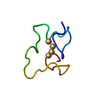
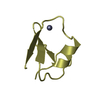

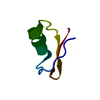

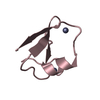


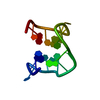
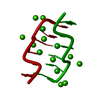
 PDBj
PDBj

